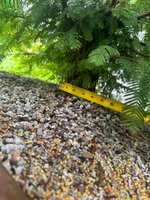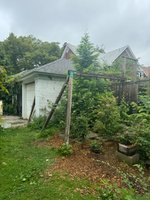Are there benefits to performing a trunk chop with the tree is in the ground (i.e., without root work)? I will be chopping a fairly large Dawn Redwood next year that is currently ground growing. My initial plan was to get the tree into a grow box at the same time as the chop, but then was wondering if the strong root system will help the future new leader develop faster (and also give me some time for a few layers).
You are using an out of date browser. It may not display this or other websites correctly.
You should upgrade or use an alternative browser.
You should upgrade or use an alternative browser.
Benefits to Chopping In-Ground?
- Thread starter dbonsaiw
- Start date
Cruiser
Omono
Your intuition is correct. The foundation is already established so it can better provide for top growth.the strong root system will help the future new leader develop faster
Last edited:
gooeytek
Shohin
The tree is likely at its strongest growing in-ground. After you do the chop, there'll be less stress for the tree, and shorter recovery.Are there benefits to performing a trunk chop with the tree is in the ground (i.e., without root work)? I will be chopping a fairly large Dawn Redwood next year that is currently ground growing. My initial plan was to get the tree into a grow box at the same time as the chop, but then was wondering if the strong root system will help the future new leader develop faster (and also give me some time for a few layers).
leatherback
The Treedeemer
With a dawn redwood less of a thing, but for many species it is actually desireable to NOT Have fast regrowth but a slower approach with shorter internodes.
Just a thought
Just a thought
Agreed. With this DR in particular, I let it grow wild probably longer than I should have. The base has got to be 4" by now (from a stick!!!) - no movement and little taper down low. Just the thought of cutting this down from over 20 feet to less than 10 inches gives me heartburn and I'm a little worried for the tree (not sure I should be). The tree is super healthy now. The new leader is going to need a lot of growing to catch up to the base.With a dawn redwood less of a thing, but for many species it is actually desireable to NOT Have fast regrowth but a slower approach with shorter internodes.
Just a thought
Wulfskaar
Masterpiece
I don't know myself... but I have seen a discussion on here a while back regarding needing/wanting to balance the roots and foliage. If I remember correctly, it was about pruning roots and branches roughly equally to maintain balance in the overall system. It may have been @rockm involved in the discussion, but I may be wrong on that too.
I can't find the actual discussion, so don't make any decisions based on this comment.
I can't find the actual discussion, so don't make any decisions based on this comment.
This concept was part of the reason for my question. I can attest that too much foliage and not enough roots leads to issues. Not sure I ever had issues the other way around with lots of roots and little foliage. Too much foliage compared to roots leads to issues because the roots can’t keep up with transpiration. I guess I just don’t understand why there should be any issue with lots of roots and little foliage - other than coarse growth. (Then again a repot will allow me to work the nebari).I don't know myself... but I have seen a discussion on here a while back regarding needing/wanting to balance the roots and foliage.
I guess I’m really asking what is the safest way to get this from a 20 foot tree to a point where I can start developing the trunk. I was even tempted to cut in stages, but I don’t really see a point/benefit to that.
Wulfskaar
Masterpiece
Trees do it in nature all the time.This concept was part of the reason for my question. I can attest that too much foliage and not enough roots leads to issues. Not sure I ever had issues the other way around with lots of roots and little foliage. Too much foliage compared to roots leads to issues because the roots can’t keep up with transpiration. I guess I just don’t understand why there should be any issue with lots of roots and little foliage - other than coarse growth. (Then again a repot will allow me to work the nebari).
I guess I’m really asking what is the safest way to get this from a 20 foot tree to a point where I can start developing the trunk. I was even tempted to cut in stages, but I don’t really see a point/benefit to that.
leatherback
The Treedeemer
The base has got to be 4" by now
a 20 foot tree
I would not be surprised if the base is a lot more than that..
-I have never grown this species!-
For species that easily throw buds on older wood I would not think twice about it and just cut to a little taller what you want to keep, and cut-clean when you have a new leader settled in place where you want it.
I make those sort of reductions in the earlier growing season after the tree has started in spring. This in my mind reduces risks of trunk die-back.
sevan
Mame
It probably depends on species and location. A few years ago I air layered the top of a water oak (Quercus nigra), which resulted in removing the top 70-80% of the tree. The tree was in an area with lots of shade and the remaining trunk died even though it still had some branches. My guess is the remaining leaves couldn't feed the roots enough.
I have not done anything similar with a dawn redwood, but I would guess that if it's in a sunny location, it would probably be fine because they grow so fast. I did a trunk chop on a massive Chinese privet, also in a shady area, and it's doing just fine. I expected it would survive and wanted to take advantage of the existing roots to grow the next section because of how big it is. But I also didn't care if it died because I am trying to remove all the privet from my yard.
I have not done anything similar with a dawn redwood, but I would guess that if it's in a sunny location, it would probably be fine because they grow so fast. I did a trunk chop on a massive Chinese privet, also in a shady area, and it's doing just fine. I expected it would survive and wanted to take advantage of the existing roots to grow the next section because of how big it is. But I also didn't care if it died because I am trying to remove all the privet from my yard.
pics are it didn't happen
These are from about a month ago and the tree has grown more. I can take more, but it’s really just a massive Christmas tree.
Attachments
Thanks. I have never chopped down a tree this large. I assume I'm chopping it to about 1/3 of the intended final height?Just find a place you want to chop and grow a new leader (spring 2025)- then the following year (spring 2026) dig up and work the roots and either plant back in the ground or put into a grow out pot
Gaitano
Shohin
I did a chop on a DR last spring. The goal was to chop it down to its eventual height. I basically chopped 1/3 rd off the top. It was in a grow box at the time. The reaction was a ton of new shoots at the cut site. I don’t think you will have any issue finding a new candidate for the new leader. This spring I put it in a pot (apparently not deep enough) and it is basically pushing itself out of the pot due to vigorous root growth.
I wish you luck when it’s finally time to dig this bad boy up.
I wish you luck when it’s finally time to dig this bad boy up.
trigo
Mame
What i have observed with my native species (tropicals) is that if you prune on the ground and leave it for a whole year, it will be better than just a hard chop and dig it out. But if you chop it on the ground, let it resprout and dig it out without letting the tree grow out, it will have a bigger chance of failure. I think that the vigor of the ground is wasted when not collected right away, unless you let it regrow. Of course this is species specific, but i think the general idea can be applied.
Glaucus
Omono
If you trunk chop, the new leader will need to be fattened up to make the transition and the taper smooth. Otherwise, the change in taper will be quite immediate and it won't be convincing as a unified tree trunk.
Fattening up the new leader will likely go faster while keeping it in the ground. Once all parts of the main trunk are fattened up enough, it makes sense to move the tree to a training container.
Fattening up the new leader will likely go faster while keeping it in the ground. Once all parts of the main trunk are fattened up enough, it makes sense to move the tree to a training container.
Similar threads
- Replies
- 24
- Views
- 3K
- Replies
- 1
- Views
- 1K


